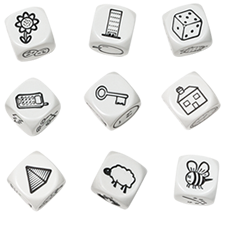
How to Teach Creative Thinking to Concrete Thinkers
My son is the type who loves checklists, schedules, scripts, anything that will make his life predictable.
But life isn’t predictable. Sooner or later, there will be a problem that he has to solve on his own. Everyone must learn how to adapt. Concrete thinking and rigid, inflexible habits are prominent features of many neurological conditions and some types of cognitive impairments. In these cases, creativity may not come naturally - it must be taught in order to develop more flexible habits and thought patterns. The therapeutic benefits of creative outlets such as drawing, writing, photography and storytelling are well-documented in medical literature. Moreover, creative thinking and problem solving are necessary life skills for everyone. To teach creative thinking to my concrete thinker, I start with structure and gradually relax it as he becomes comfortable. Here’s a step-by-step guide to show the way.1. Show that creativity is always an option
Often it doesn’t even occur to my son that there might be more than one way to do something. So I ask him for alternative solutions to everyday problems. Since all humans learn through play, play therapy is the ideal way to practice exploring multiple solutions to a challenge. Here’s a step-by-step guide to getting started with play therapy.
2. Show that you value creative expression
Valuing creative expression is more than visiting art fairs, museums and theaters. It means being curious about the world and asking questions: What? How? Why? It also means looking for the answers in unusual places - under a rock, up in the attic, through a telescope or in the mirror. 3. Share and tell stories
3. Share and tell stories
Storytelling is an ancient tradition across all cultures, and it’s an important part of cognitive development. My son still needs prompts to tell a story, so a friend gave him Rory’s Story Cubes, a simple game with 9 dice. Each piece has tiny icons that can be used to tell a story.
4. Fix something
Whether it’s a broken toy or a scraped knee, there’s usually more than one way to make it better. Instead of using commands to get the job done, try being a little more introspective: “Hmmm, I need something sticky to put these pieces back together...now I need to put this somewhere safe while the glue dries.” Allow your concrete thinker to suggest or improvise each step of the process with you.
5. Photography
 One summer I took my son to an outdoor art fair, and we looked at elegant photographs of stairwells. My son’s lifelong passions are skyscrapers, elevators and stairs, so he was enchanted by the photos. I told him, “Maybe someday you will be an artist who takes pictures of stairs and elevators.”
One summer I took my son to an outdoor art fair, and we looked at elegant photographs of stairwells. My son’s lifelong passions are skyscrapers, elevators and stairs, so he was enchanted by the photos. I told him, “Maybe someday you will be an artist who takes pictures of stairs and elevators.”
This thought took root in his mind, and now he tells everyone that he will be an artist when he grows up -and he wants his own camera. His photos allow me to see his point of view and what he considers significant: street signs with familiar names, blurry photos of his brother running away, stuffed animals lined up and several photos of me while driving.
6. Poetry
Poetry is for everyone. A sophisticated command of language is not a requirement for writing poetry. In fact, simple words often have a more lasting impact than complex metaphors. Haiku poems are fun to write because they combine counting syllables with word choices - the first line has 5 syllables, the second line has 7 syllables and the third line has 5 syllables.
My son prefers acrostic poems that spell out a thematic word horizontally with descriptive words or phrases written horizontally. He used a dictionary to write this poem without any assistance: Thankful Toys.House.
Arboretum and Art Museums.
Nature walks.
Knowledge.
Friends.
Understanding.
Love.
7. Cooking
Even when following a recipe closely, there is always some improvising in the kitchen. Encourage your concrete thinker to decide if a little more of this or that is needed, if the stove needs to be turned up or down, if the cookies need an extra 2 minutes to bake.
8. Make a book
Creating a book on a beloved subject gives the author a sense of authority and expertise. Last year my son collected his acrostic poems, stapled them together, glued a photo he took on a nature walk to the cover, and gave copies of his book to family and friends. This act of generosity opened up new conversations for him.
9. Sketching
Drawing and sketching help with attention, fine motor skills, visualization skills and anxiety reduction. This is exactly the type of activity that my son tries to avoid! To encourage sketching, I give him pages from “Doodles at Dinner” by Deborah Zemke. Each page is a placemat with instructions for sketching a specific object, centered around a letter or number. For example, to draw a bighorn sheep, start with the number 6 for the horn, and add the curves and waves for the head and body one at a time. My son likes this structured format because he likes working with letters and numbers.
10. Painting
 My biggest triumph of the past year was teaching my children how to paint on canvas. I found a set with step-by-step instructions from Social Artworking. The project took almost 2 hours to complete. First I had my children trace the outline of a flower onto their canvases, then I gave them each one paintbrush and one color at a time while repeating the instructions.
My biggest triumph of the past year was teaching my children how to paint on canvas. I found a set with step-by-step instructions from Social Artworking. The project took almost 2 hours to complete. First I had my children trace the outline of a flower onto their canvases, then I gave them each one paintbrush and one color at a time while repeating the instructions.
Even though we all followed the same instructions, we finished with three different paintings - each painting was beautiful in a different way. That’s the point of creative thinking.
So... How do you encourage creative thinking? Share in the comments below.



